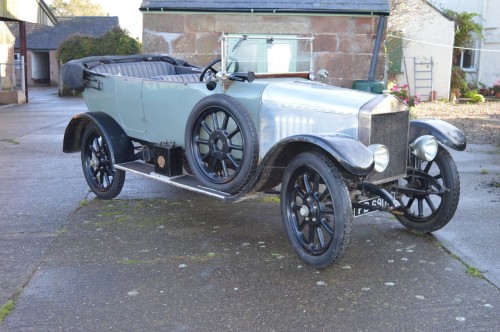
Click Here for Full Screen Image - Click Here to Download Image
 |  |  |  |  | |||||
 |  |  |  |  | |||||
 |  |  |  |  | |||||
 |  |  |  |  | |||||
 |  |
| Lot number | 142 |
|---|---|
| Hammer value | £14,000 |
| Description | Varley Woods 4-Seat Tourer |
| Registration | PB 6903 |
| Year | 1920 |
| Colour | Grey |
| Engine size | 1,794 cc |
| Chassis No. | 332 |
| Engine No. | 12431 |
Following the Great War, a significant number of entrepreneurial types set about trying to make their fortune through Government Surplus.
Ernest Vernon Varley Grossmith (try saying that after a couple of pints) was one of the more colourful ones, adding the manufacture of tin cans and mouth-organs to his eclectic portfolio. The son of a wealthy family of perfumiers and stage artistes, he formed the High Speed Tool Company operating out of a disused laundry in Acton.
In early 1918 he met with John Woods, an African river trader no less, and appointed him director. By the end of 1918 Grossmith had side-stepped the original business and dropped his German sounding name, calling himself simply Ernest Varley.
A new venture was initiated out of the laundry, High Speed Motors, and a straightforward car was introduced, built out of proprietary components assembled on a chassis made for them by Turners of Wolverhampton . Sadly, a year later, after only a few had been completed, the creditors called it a day and bailiffs sealed up the laundry doors.
Ever resourceful, Varley and Woods knocked a hole in the rear of the building and removed all items of value, taking them to new rented buildings in Wolverhampton to continue manufacture. That's the spirit!
Their new model used the well-proven 1,794cc OHV Dorman engine mated to a gearbox of their own design and manufacture. Despite being extremely well engineered, their whopping £725 price tag (for the basic tourer) ensured sales were limited, some 160 cars leaving the factory before the receivers came knocking once again at the end of October 1920.
Having had enough of car manufacture, Ernest Woods sold off the family’s large country house and retired to a small cottage in Cornwall, while his partner, John Woods, returned to Nyasaland where he was eventually eaten by a lion!
Despite being killed off by its small scale of manufacture, the high cost of bought in components and lack of cash, the Varley Woods was nevertheless a thoroughly well-engineered vehicle.
Believed to be the sole survivor, this Varley Woods has been in its current ownership since 1988. The subject of an in-depth article in The Automobile magazine, it creates a huge amount of interest amongst the cognoscenti, those ‘not in the know’ getting very confused by the VW on the radiator!
Little used over the last few years, it remains in lovely original condition. The vendor has always started it on the handle, a Brolt starter motor being supplied with the car but not fitted. The lighting is also of Brolt manufacture and an Auster-type screen fits onto lovely nickel brackets in the rear, protecting the rear passengers and indicating the level of quality built into the car.
The large silencer is a work of art, being made of cast aluminium, and the rear springs are long cantilevered semi-elliptics - a real Edwardian carry-over. A compartment under the rear floor houses a spare magneto and carburettor, along with sundry other useful spare parts.
Its use of bought-in components makes it a practical proposition to run, its failure in the market in period being through its high cost of manufacture rather than any fundamental design flaw. The careful design and relatively light overall weight give it performance on a par with most early 1920's tourers, making the car a very interesting alternative to an early Austin 12 or its local competition from Sunbeam and Bean.
The new owner will have to get used to being quizzed about this exceedingly rare machine by everyone who sees it as the name Varley Woods is completely unknown to 99% of other vintage car owners.